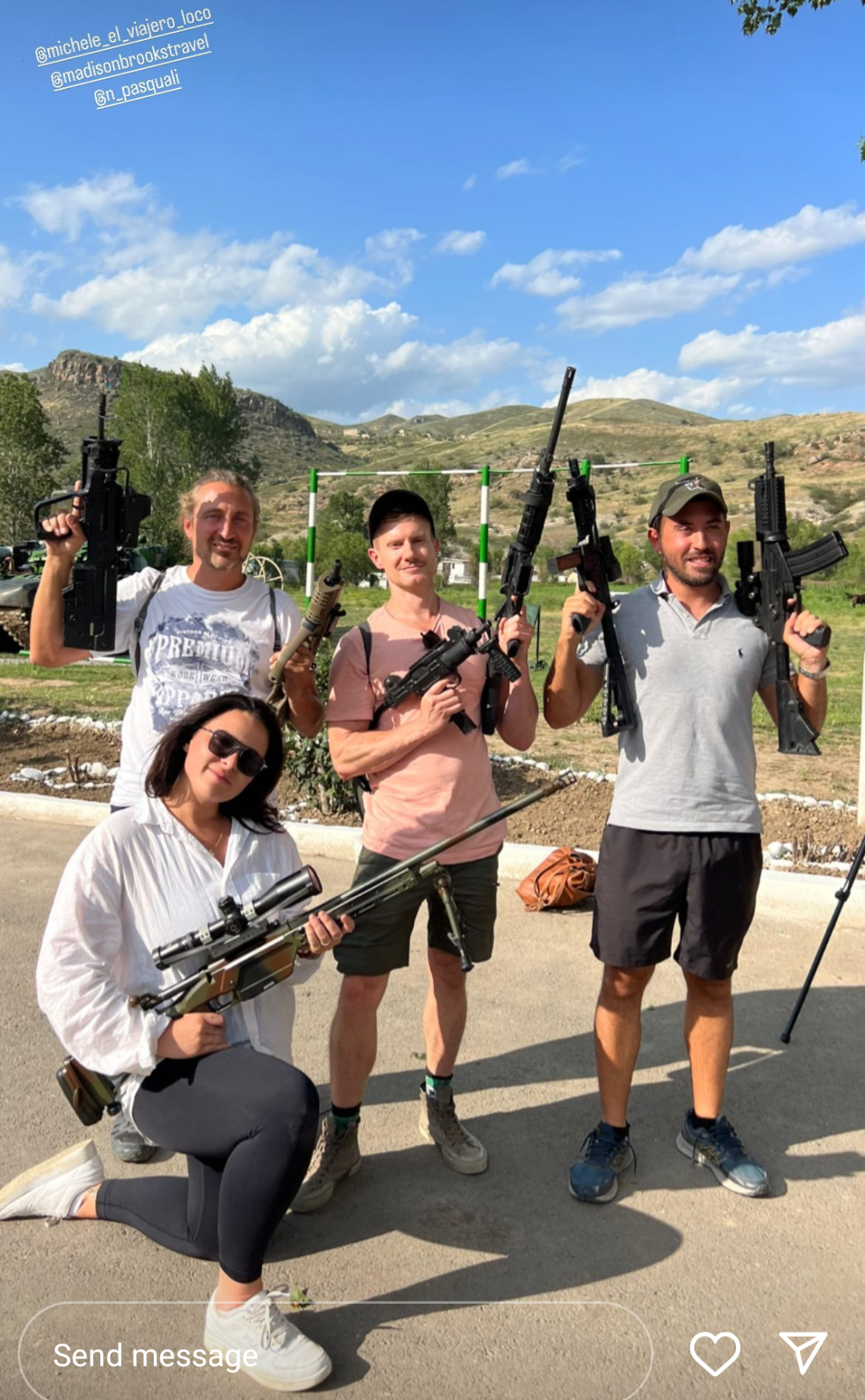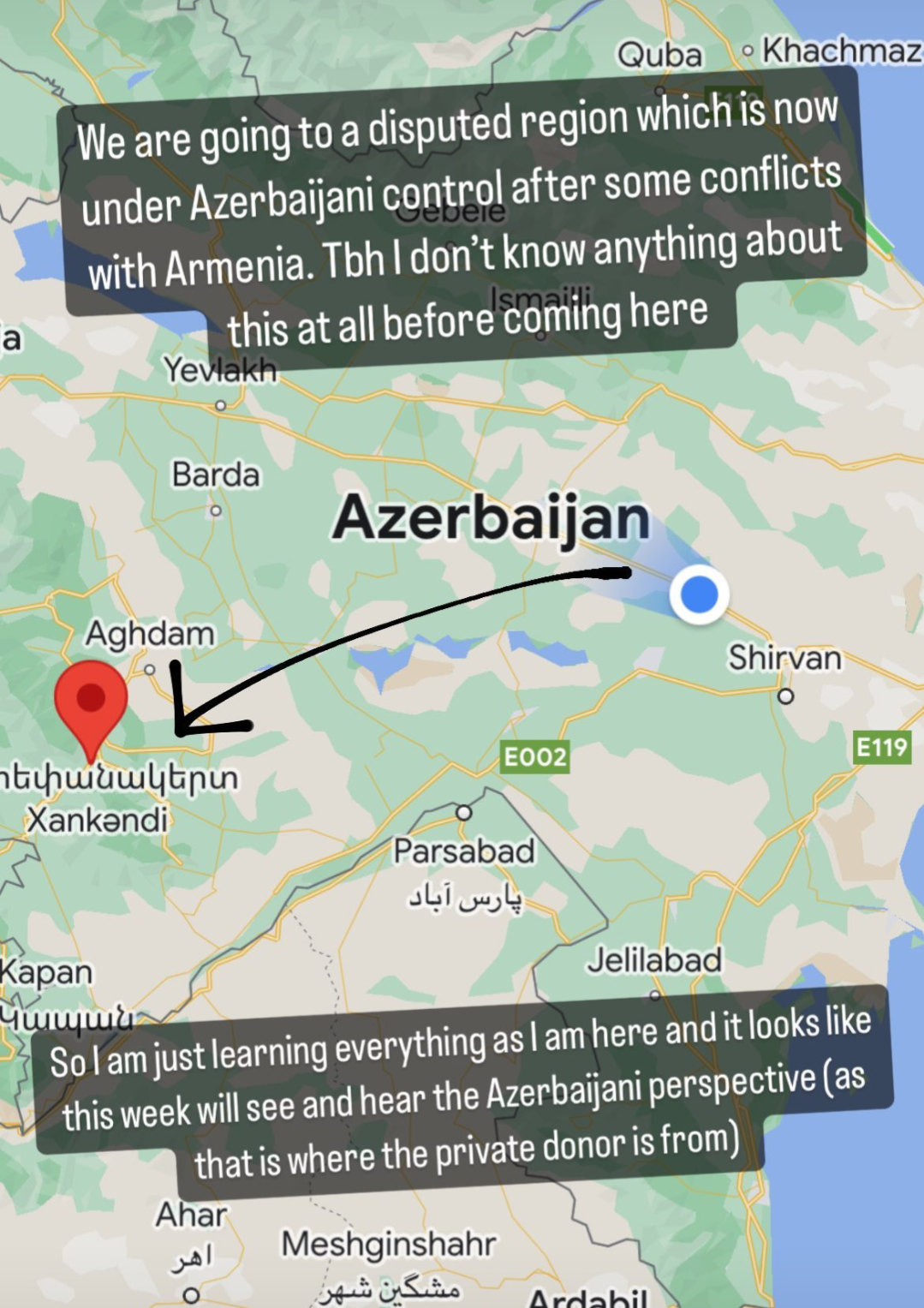Imagine being offered the chance for incredible adventures as one of the first travelers to tour “previously restricted areas” – and best of all, it’s free! Sounds too good to be true, right? Indeed it is. As members of the global community of “extreme travelers” chasing excitement have been discovering, everything has its price. All expenses paid trips to Nagorno-Karabakh (Artsakh) offered to travelers by the Azerbaijani government aim to promote the nation’s image through social media influencers and use their interviews with the press to further the country’s propaganda objectives. These practices have deep ethical implications with consequences for both the influencers involved and the wider international community.
By inviting social media influencers to Azerbaijan and the Nagorno-Karabakh region, the government of Azerbaijan seeks to present an image of prosperity, development and stability in the disputed area, at a time when its treatment of Armenians and Azerbaijani dissidents alike has garnered it bad press. These unsuspecting tourists have become another arm of the Azerbaijani propaganda machine, along with bribed international officials, corrupted politicians and a hyperactive bot army.
Each trip follows the same format, which can be tracked through the Instagram stories the influencers share along the way. The most egregious part of the adventure, which is also one of its highlights, is a stop at a military base in Gubatly right along the Armenian border, where the travelers pose with all manner of weaponry and drive around in tanks. They are even given the chance to fire actual weapons at imagined enemies, most likely in the direction of the besieged Armenian population living just kilometers away. One particularly zealous tourist from Brazil even donned Azerbaijani military fatigues as he fired weapons for his Instagram story—all this less than three years after thousands of soldiers were killed in those very fields.

Cocooned within the perceived safety of an official government trip, this ghoulish behavior is in fact by design. As pro-government Azerbaijani media reported last September, these trips are “of exceptional importance for promotion of the liberated territories [Karabakh] as part of ‘black [dark] tourism’”. Trips to the sites of tragedy and death, known as “dark tourism,” have become a source of big money in recent years. Despite its name, however, genuine “dark tourism” is not intended to be a celebration of war or morally dubious behavior, and one of the leading dark tourism websites has issued a warning that participation in these trips is not acceptable, as it violates the principles of dark tourism and “clearly serves the dictatorial state’s propaganda”. For Azerbaijan, it isn’t just an opportunity to spread propaganda, but also a means of advertising to attract future paying thrill-seeking tourists and boost its international image. Even more fraught is the fact that, judging from much of the social media content shared by attendees, they knew absolutely nothing about the conflict upon arrival. This puts them in a very vulnerable position, which is useful to their host’s designs but liable to backfire on the participants themselves.
One of the influencers experienced this first-hand on June’s “Shusha-2023 Expedition” tour, done in partnership with the travel club MTP (Most Traveled People) and led by its founder Charles Veley. On July 21, South African traveler Petro Marais posted a video of herself from the month prior smiling and eating ice-cream at a “fully stocked supermarket” located in Shushi, while harrowing stories circulated of the empty supermarkets, widespread hunger, and even malnutrition-induced miscarriages affecting the Armenian population just down the hill from there. The video went viral, with journalist Lindsey Snell calling it “among the most repugnant things I’ve seen during Azerbaijan’s 7+ month blockade of Nagorno-Karabakh.” This is not to say Marais intended malice by her seemingly innocent story. She likely didn’t know about the ongoing blockade at all, and her hosts certainly wouldn’t have told her about it. Yet this is the kind of danger that influencers invite when they allow themselves to be lured by a free trip into becoming hapless tools of a propaganda machine. This lack of awareness not only compromises their integrity but also misleads their followers, undermining the credibility that influencers often strive to maintain.
By exploiting the influence and reach of social media personalities, the government seeks to shape international perceptions while sidestepping the complexities of the long-standing conflict. By going so far as to place the visiting influencers into the tanks and uniforms of the Azerbaijani forces, it symbolically enlists them in the cyberwar against Armenians while using their platforms and words to conceal ongoing atrocities.
Another tactic seen in the social media videos is how ever-present Azerbaijani journalists ambush participants at inopportune times, creating an environment of pressure to speak about something the travelers have very little knowledge about. As one of the travelers described in an Instagram story early in the June trip, “We are being followed around all this week by local TV and media. They keep pulling all the foreigners for quick interviews, and it’s online within the hour. I’ve managed to avoid so far!” They did eventually get him, and he gave the press a very neutral response, which seemed to disappoint the journalist from her expression. The traveler tellingly captioned the video, “They want you to stick to a script…” The number of cameras following the participants at all times gave the trip the look and feel of a reality show rather than a vacation. These photos of Marais, shared by Snell, show her being interviewed by no less than six separate local outlets at once. During February’s tour, they went to the site of the government-sponsored protest that closed the Berdzor (Lachin) Corridor, to promote the false talking point that there was no blockade against Armenians.
Some, like Marais, have learned the hard way that even if the Azerbaijani journalists do not get the ideal quote they want, that won’t stop them from making it up. In the wake of the backlash her posts received, she issued a statement about her trip to Azerbaijan, in which she made the following claims:
“There is a video clip released by an Azerbaijani media outlet going around with a quote that has been falsely attributed to me. This is something I never said. I was not aware prior to attending the trip there would be cameras following me the entire trip. I was not paid to attend this tour however all expenses was [sic] covered. While I understand this is a propaganda tour to the region, I agreed since this is a unique opportunity to network with other travelers and to visit a place that is impossible to visit independently.”
In light of the notoriety of Azerbaijan’s “caviar diplomacy” and the corruption of the Azerbaijani Laundromat, the claim “I wasn’t paid” has become a common defense among those who take such trips but do not feel they monetarily benefited from them. However, accepting a free trip, accommodations, and getting wined and dined along the way is still accepting a gift. Cash is not the only form of bribery.

Even travelers who were careful not to get co-opted still managed to inadvertently promote Azerbaijani propaganda. The theme of reconstruction and the return of displaced Azerbaijani IDPs to the Karabakh region is a major component of the tours. Tours visit construction sites in the currently empty Armenian village of Talish, where new homes have been built to house Azerbaijani settlers to replace the native Armenian population. One traveler inadvertently promoted a narrative of Talish as a successful example of expedient construction to facilitate a “return,” when in fact what he was looking at was the result of ethnic cleansing by the very government that was hosting him. Further reiterating the Azerbaijani government’s stamp on the trip, it wrapped up with a special breakfast with President Aliyev’s assistant (and chief propagandist) Hikmet Hajiyev.
While these free trips are still a relatively new phenomenon, the June trip was the seventh so far, Azerbaijan is aggressively pursuing more participants. As their true nature is exposed however, some travel groups are reconsidering the wisdom in partnering with Azerbaijan. Karabakh trips have been conducted in partnership with travel organizations such as ETIC (Extreme Traveler International Congress), TCC (Travelers’ Century Club), Nomadmania and MTP, which Azerbaijan relies upon to source its interested travelers. The May trip was done in partnership with the organization Club 100, after which it received negative press in Sweden. Club 100 chairperson Reine Larshans, who had not attended, told the Swedish outlet Blankspot, “I expect the [organization’s] board to distance itself from trips like this sponsored by a totalitarian regime which, to top it all off, are carried out in a war zone where the gunpowder smoke has hardly settled. All members can go wherever they want as private individuals, but if you make a trip in the name of the club, you must be careful and not allow yourself to be used for propaganda purposes.”
The Azerbaijani government’s attempts to organize all expenses paid trips for influencers to the disputed Nagorno-Karabakh region for propaganda purposes are loaded with ethical implications. By exploiting the influence and reach of social media personalities, the government seeks to shape international perceptions while sidestepping the complexities of the long-standing conflict. By going so far as to place the visiting influencers into the tanks and uniforms of the Azerbaijani forces, it symbolically enlists them in the cyberwar against Armenians while using their platforms and words to conceal ongoing atrocities. By ignoring the complex historical and geopolitical realities on the ground, and erasing the legitimate grievances and claims of the ethnic Armenian population in Nagorno-Karabakh, these influencers are not just accepting a free trip but doing active harm by deepening existing divisions and making the path to a peaceful resolution even more challenging. Ultimately, it is essential to advocate for transparency, accuracy and respect from influencers, tourists and travel organizations, making them aware of the damage they are doing by accepting these free trips, and instead foster an environment where unbiased and informed perspectives lead the way.



AS MUCH AS I HATE WHAT AZERBAIJAN IS DOING, ARMENIA IS BECOMING A WHINING AND CRYING BABY, ALWAYS THROWING A TANTRUM ANYTIME AZERBAIJAN COMES UP WITH A STUPID BUT SUCCESSFUL MARKETING CAMPAIGN AGAINST IT. YES, IT’S DUMB, IT’S DISGUSTING, AND THESE SOCIAL MEDIA INFLUENCERS ARE A BUNCH OF MORONS. HOWEVER, IT WORKS AND AZERBAIJAN IS OUTSMARTING ARMENIA IN ITS MEDIA CAMPAIGN AGAINST IT.